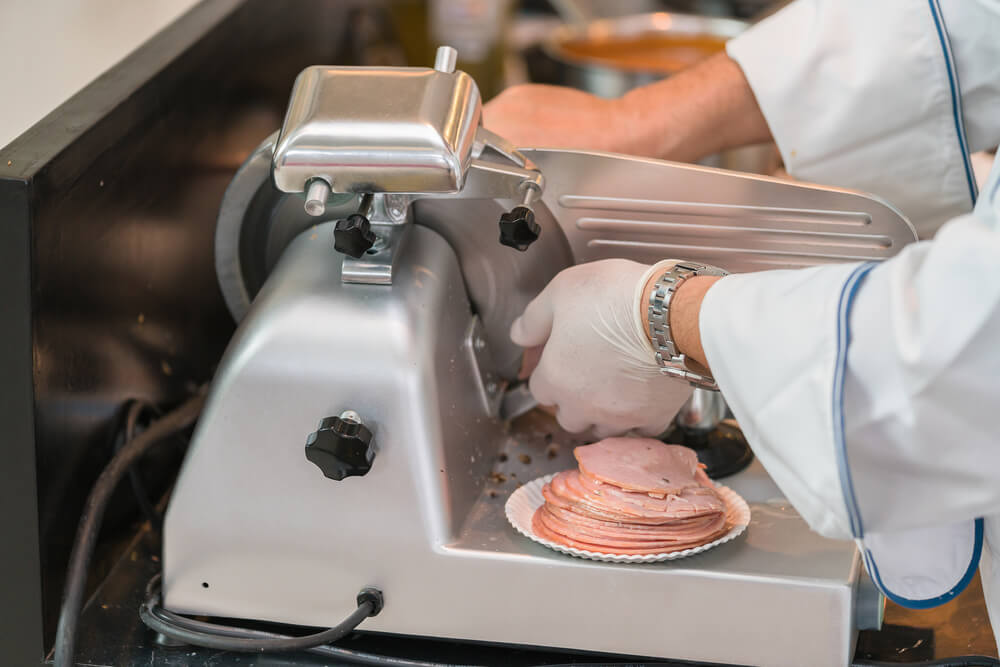Meat slicers can slice and dice up just about any kind of meat and are found in most restaurant kitchens and many residential ones as well. Picking the best meat slicer means not only knowing the brands, but also all the ins and outs of how these machines work.
Sometimes referred to as a deli slicer or slicing machine, a meat slicer’s job is straightforward: cut through meats, cheeses, and other food products. Originally these machines used a crank for their primary movement, with modern models now opting in for an electric motor.
While meat slicers can cover most of your cutting needs, there are other types of slicers that do specific things. Spiral vegetable slicers take most hard vegetables like potatoes and carrots and turn them into spaghetti-like strands. There are also tomato and egg slicers as well.
What Are the Differences Between Meat Slicer Models?
There are many different factors to be aware of when purchasing a meat slicer. As expected, lower priced slicers are considered lower quality and are thus more for entry-level use. Heavier duty models have a higher price tag but can cut faster, longer, and just generally do more work.
Entry-level models are great for residential use, as they are designed to be easy to use. National Band Saw Co, which sells low cost Hobart replacement parts for meat slicers, notes that these devices aren’t recommended for more than an hour or two of use per day. While safe to use, these devices typically do poorly when cutting other foods like cheese.
Mid-tier models are generally an upgraded version of the entry-level versions in just about every way. They have larger bodies, blades, and just generally more motor horsepower to slice through tougher food material like thicker meats and vegetables.
Premium models are designed for restaurants and can handle several hours of work per day. These models can easily slice through just about all meats and vegetables, along with cheeses. They are generally more precise, smoother, and safer.
What Kind of Blade Do I Need?
More light duty blades are less than 10 inches. These type of blades usually only need ¼ horsepower to move and are great for most meats and vegetables. 12-inch blades are by far the most common and can typically cut most food products with ease.
Hollow ground blades are a must have for those that want the sharpest edge possible. They are known for slicing through just about anything without the smallest bit of wear or tear on either the blade or motor.
What Other Parts Are Important to Consider?
The two primary types of motors are determined by the transmission. This is the power transferred from the motor to the blade itself. The two types of transmissions are either belt-driven or gear-driven. Gear-driven is notable for being hardier and handling a larger workload than their belt-driven cousins, so they are considered the superior option. This isn’t a one-way street though; belt-driven models are not only cheaper to purchase but also considerably cheaper and easier to fix if broken.
Blade size and motor power are both important, but the material the slicer is constructed from can be a factor as well. The blade can be coated in a hardened chrome or stainless steel, with chrome typically being the best choice.
A meat slicer can be incredibly dangerous, and it is important to get one that is outfitted with the best safety features. No-voltage release prevents the slicer from resuming operation when the power turns back on, while a good knife guard can shield an operator’s fingers from slices.
What Are Some of the Best Meat Slicer Brands?
While there are plenty of great brands on the market nowadays, there are a few that stand out head and shoulders above the rest. When looking at meat slicers, make sure to keep an eye out for Bizerba, Berkel, and Globe, as they have been shown to work better and longer than others.
Conclusion
Meat slicers are great machines that come in a large variety of forms that are great from everything from amateur to professional use. Brand name does matter, but make sure to also check out the blade size, motor power, and safety features as well.
Another thing to be aware of is that there are multiple different ways a slicer can break, regardless of how good quality they are. Manufacturer warranties can cover the cost of repair, and there are also guides and part catalogs to fix the slicers yourself.

